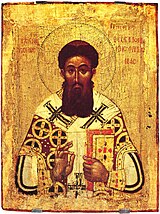
Back Таворска светлина Bulgarian Taborlicht German Luz de Tabor Spanish Sinar Tabor ID Luce del Tabor Italian Taborleech LI Taboro šviesa Lithuanian Tabora gaisma Latvian/Lettish Luz tabórica Portuguese Lumina taborică Romanian

| Part of a series on |
| Palamism |
|---|
 |
|
|
In Eastern Orthodox Christian theology, the Tabor Light (Ancient Greek: Φῶς τοῦ Θαβώρ "Light of Tabor", or Ἄκτιστον Φῶς "Uncreated Light", Θεῖον Φῶς "Divine Light"; Russian: Фаворский свет "Taboric Light"; Georgian: თაბორის ნათება) is the light revealed on Mount Tabor at the Transfiguration of Jesus, identified with the light seen by Paul at his conversion.
As a theological doctrine, the uncreated nature of the Light of Tabor was formulated in the 14th century by Gregory Palamas, an Athonite monk, defending the mystical practices of Hesychasm against accusations of heresy by Barlaam of Calabria. When considered as a theological doctrine, this view is known as Palamism after Palamas.[1][2]
The view was very controversial when it was first proposed, sparking the Hesychast controversy, and the Palamist faction prevailed only after the military victory of John VI Kantakouzenos in the Byzantine civil war of 1341–1347. Since 1347, it has been the official doctrine in Eastern Orthodoxy, while it remains without explicit affirmation or denial by the Catholic Church. Catholic theologians have rejected it in the past,[year needed] but the Catholic view has tended to be more favourable since the later 20th century.[3] Several Western scholars have presented Palamism as compatible with Catholic doctrine.[4] In particular, Pope John Paul II in 1996 spoke favourably of hesychast spirituality,[5][6] and in 2002 he named the Transfiguration as the fourth Luminous Mystery of the Holy Rosary.[7]
- ^ John Meyendorff, "Mount Athos in the Fourteenth Century: Spiritual and Intellectual Legacy" in Dumbarton Oaks Papers 1988
- ^ R.M. French, Foreword to Nicolaus Cabasilas, Joan Mervyn Hussey, P. A. McNulty (editors), A Commentary on the Divine Liturgy (St Vladimir's Seminary Press 1974 ISBN 978-0-913836-37-8), p. x
- ^ "the Western world has started to rediscover what amounts to a lost tradition. Hesychasm, which was never anything close to a scholar's pursuit, is now studied by Western theologians who are astounded by the profound thought and spirituality of late Byzantium." The Transfiguration in Byzantine Theology and Iconography (St Vladimir's Seminary Press 2005, ISBN 0-88141-295-3), pp. 215-216.
- ^ Michael J. Christensen, Jeffery A. Wittung (editors), Partakers of the Divine Nature (Associated University Presses 2007 ISBN 0-8386-4111-3), p. 243
- ^ "Pope John Paul II 11 August 1996 Angelus". www.ewtn.com. Retrieved 2018-01-09.
- ^ Original text (in Italian) Speaking of the hesychast controversy, Pope John Paul II said the term "hesychasm" refers to a practice of prayer marked by deep tranquillity of the spirit intent on contemplating God unceasingly by invoking the name of Jesus. While from a Catholic viewpoint there have been tensions concerning some developments of the practice, the Pope said, there is no denying the goodness of the intention that inspired its defence, which was to stress that man is offered the concrete possibility of uniting himself in his inner heart with God in that profound union of grace known as Theosis, divinization.
- ^ Cite error: The named reference
Rosariumwas invoked but never defined (see the help page).
© MMXXIII Rich X Search. We shall prevail. All rights reserved. Rich X Search